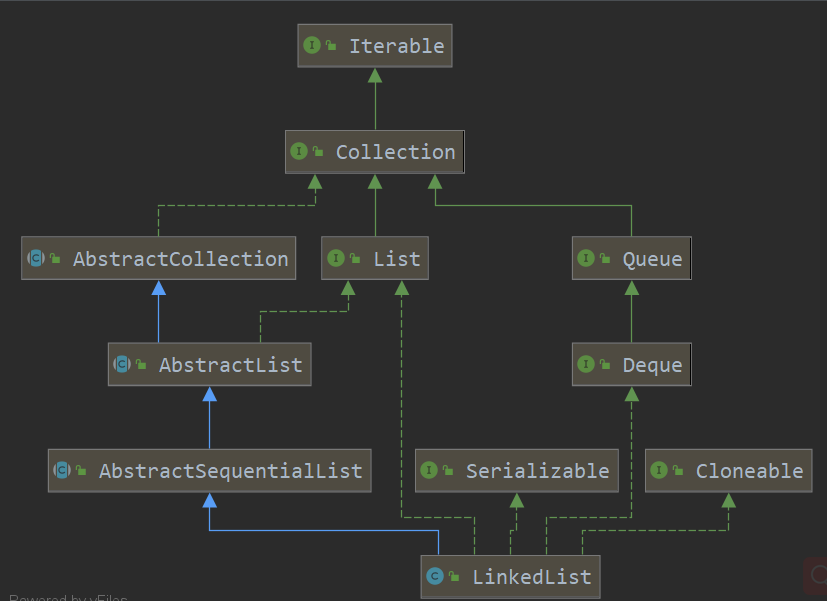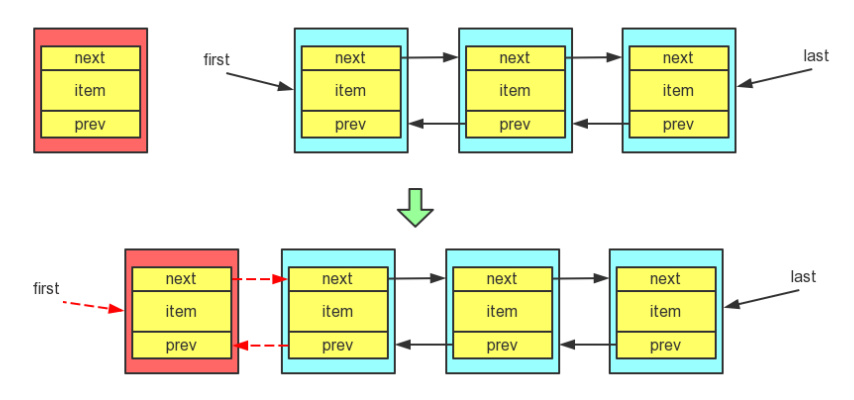LinkedList 的实现原理
本文为博客园作者所写: 一寸HUI,个人博客地址:https://www.cnblogs.com/zsql/
简单的一个类就直接说了。LinkedList 的底层结构是一个带头/尾指针的双向链表,可以快速的对头/尾节点 进行操作,它允许插 入所有元素,包括 null。 相比数组(这里可以对比ArrayList源码分析进行查看),链表的特点就是在指定位置插入和删除元素的效率较高,但是查找的 效率就不如数组那么高了。如果熟悉双向链表这个数据结构,其实就很简单了,无非就是实现一些数据的添加,删除,查询,遍历等功能,双向链表的结构图如下:

每一个数据(节点)都包含3个部分,一个是数据本身item,一个是指向下一个节点的next指针,还有就是指向上一个节点的prev指针,另外,双向链表还有一个 first 指针,指向头节点,和 last 指针,指向尾节点。,在LinkedList类中通过私有的静态内部类Node作为每一个数据的封装。具体实现如下:
private static class Node<E> { //这个类就是用来封装双向链表中的每一个数据,也是上图中的每一个框
E item;
Node<E> next;
Node<E> prev;
Node(Node<E> prev, E element, Node<E> next) {
this.item = element;
this.next = next;
this.prev = prev;
}
}
接下看看LinkList类的定义:
public class LinkedList<E>
extends AbstractSequentialList<E> //继承的类
implements List<E>, Deque<E>, Cloneable, java.io.Serializable //实现的各种接口
{}

接下来看看LinkedList这个类的一些属性:就三个属性,一个用来记录双向链表的大小,一个是first节点用来指向链表的头,last用来指向链表的尾
transient int size = 0;
/**
* Pointer to first node.
* Invariant: (first == null && last == null) ||
* (first.prev == null && first.item != null)
*/
transient Node<E> first;
/**
* Pointer to last node.
* Invariant: (first == null && last == null) ||
* (last.next == null && last.item != null)
*/
transient Node<E> last;
在看看构造方法:
/**
* Constructs an empty list.
*/
public LinkedList() { //空参构造
} /**
* Constructs a list containing the elements of the specified
* collection, in the order they are returned by the collection's
* iterator.
*
* @param c the collection whose elements are to be placed into this list
* @throws NullPointerException if the specified collection is null
*/
public LinkedList(Collection<? extends E> c) { //通过已有的集合进行构造
this();
addAll(c); //使用addAll()方法把集合中的数据生产LinkedList
} public boolean addAll(Collection<? extends E> c) {
return addAll(size, c);
} public boolean addAll(int index, Collection<? extends E> c) {
checkPositionIndex(index); Object[] a = c.toArray(); //把集合转为数组
int numNew = a.length;
if (numNew == 0)
return false; Node<E> pred, succ;
if (index == size) {
succ = null;
pred = last;
} else {
succ = node(index);
pred = succ.prev;
} for (Object o : a) { //对数组进行遍历,对每一个元素都封装成Node并添加到LinkedList中
@SuppressWarnings("unchecked") E e = (E) o;
Node<E> newNode = new Node<>(pred, e, null);
if (pred == null)
first = newNode;
else
pred.next = newNode;
pred = newNode;
} if (succ == null) {
last = pred;
} else {
pred.next = succ;
succ.prev = pred;
} size += numNew;
modCount++;
return true;
}
接下来看看LinkedList的基本操作,添加,删除,遍历,查询等
先看添加,从双向链表的结构来看,添加元素可以在链表的头、尾、以及中间的任意位置添加新的元素。因为 LinkedList 有头指针和尾指针,所以在表头或表尾进 行插入元素只需要 O(1) 的时间,而在指定位置插入元素则需要先遍历一下链表, 所以复杂度为 O(n)。首先看看在头部添加元素:

看图可以看出,只要把first指向新的node,新的node的next指向原先firt指向的node,再把原先first指向的node的prev指向新的node就可以了。
/**
* Links e as first element.
*/
private void linkFirst(E e) {
final Node<E> f = first; //使用临时node
final Node<E> newNode = new Node<>(null, e, f); //封装新的node,并把新node的nex指向f
first = newNode;
if (f == null) //判断first是否为空
last = newNode;
else
f.prev = newNode; //把f的prev指向新的node
size++; //链表长度加1
modCount++; //记录链表被修改的次数
}
在看看在尾部添加,其实和在头部添加一样,只是把first换成了last,逻辑一样
/**
* Links e as last element.
*/
void linkLast(E e) {
final Node<E> l = last;
final Node<E> newNode = new Node<>(l, e, null);
last = newNode;
if (l == null)
first = newNode;
else
l.next = newNode;
size++;
modCount++;
}
再看看在中间的任意位置添加:

这个相对来说复杂点点,修改添加前后node的next和prev的指向,修改的相对来说多点点
/**
* Inserts element e before non-null Node succ.
*/
void linkBefore(E e, Node<E> succ) { //表示在在succ节点前面添加e元素
// assert succ != null;
final Node<E> pred = succ.prev; //获取succ的前面节点
final Node<E> newNode = new Node<>(pred, e, succ); //把e封装成节点,并把prev指向succ前面节点,把next指向succ节点
succ.prev = newNode; //然后把succ的prev指向新的节点
if (pred == null)
first = newNode;
else
pred.next = newNode; //把succ的前节点的next只想新的节点
size++; //链表长度+1
modCount++; //修改次数+1
}
添加说完了,就说说删除,其实也很简单

删除也是分为从头部、尾部、中间位置删除
先看看从first位置删除
/**
* Unlinks non-null first node f.
*/
private E unlinkFirst(Node<E> f) {
// assert f == first && f != null;
final E element = f.item; //获取first中间的元素,用于后面的返回
final Node<E> next = f.next; //获取f的next节点
f.item = null;
f.next = null; // help GC 清除
first = next; //把first指向f的next
if (next == null)
last = null;
else
next.prev = null; //清除
size--; //链表长度-1
modCount++; //修改次数+1
return element;
}
看了从头部删除,其实尾部删除也差不多
/**
* Unlinks non-null last node l.
*/
private E unlinkLast(Node<E> l) {
// assert l == last && l != null;
final E element = l.item;
final Node<E> prev = l.prev;
l.item = null;
l.prev = null; // help GC
last = prev;
if (prev == null)
first = null;
else
prev.next = null;
size--;
modCount++;
return element;
}
在看看从指定位置删除吧
/**
* Unlinks non-null node x.
*/
E unlink(Node<E> x) {
// assert x != null;
final E element = x.item; //获取该节点的值
final Node<E> next = x.next; //获取该节点的next节点
final Node<E> prev = x.prev; //获取该节点的prev节点 if (prev == null) { //把该节点的前节点的next指向该节点的next节点,并清除该节点的prev指向
first = next;
} else {
prev.next = next;
x.prev = null;
} if (next == null) { //把该节点的next节点的prev指向该节点的prev节点,并清除该节点的next指向
last = prev;
} else {
next.prev = prev;
x.next = null;
} x.item = null; //清除
size--; //链表长度-1
modCount++; //修改次数+1
return element;
}
看完增删,那就继续看查相关的方法,也有从头,尾相关的查询方法,都很简单,做判断,然后查询
/**
* Returns the first element in this list.
*
* @return the first element in this list
* @throws NoSuchElementException if this list is empty
*/
public E getFirst() {
final Node<E> f = first;
if (f == null)
throw new NoSuchElementException();
return f.item;
} /**
* Returns the last element in this list.
*
* @return the last element in this list
* @throws NoSuchElementException if this list is empty
*/
public E getLast() {
final Node<E> l = last;
if (l == null)
throw new NoSuchElementException();
return l.item;
}
当然还有指定index查询的
/**
* Returns the (non-null) Node at the specified element index.
*/
Node<E> node(int index) {
// assert isElementIndex(index);
//判断index是在链表的前半段还是在后半段,如果在前半段就从first向后遍历,否则使用last向前遍历
if (index < (size >> 1)) {
Node<E> x = first;
for (int i = 0; i < index; i++)
x = x.next;
return x;
} else {
Node<E> x = last;
for (int i = size - 1; i > index; i--)
x = x.prev;
return x;
}
}
其实基本知道了上面的方法基本对双向链表有了一定的熟悉,当然LinkedList还有很多其他的方法,不过很多都是基于上面这些方法的一些封装,例如:
/**
* Inserts the specified element at the beginning of this list.
*
* @param e the element to add
*/
public void addFirst(E e) {
linkFirst(e);
} /**
* Appends the specified element to the end of this list.
*
* <p>This method is equivalent to {@link #add}.
*
* @param e the element to add
*/
public void addLast(E e) {
linkLast(e);
}
/**
* Removes and returns the first element from this list.
*
* @return the first element from this list
* @throws NoSuchElementException if this list is empty
*/
public E removeFirst() {
final Node<E> f = first;
if (f == null)
throw new NoSuchElementException();
return unlinkFirst(f);
} /**
* Removes and returns the last element from this list.
*
* @return the last element from this list
* @throws NoSuchElementException if this list is empty
*/
public E removeLast() {
final Node<E> l = last;
if (l == null)
throw new NoSuchElementException();
return unlinkLast(l);
}
/**
* Appends the specified element to the end of this list.
*
* <p>This method is equivalent to {@link #addLast}.
*
* @param e element to be appended to this list
* @return {@code true} (as specified by {@link Collection#add})
*/
public boolean add(E e) {
linkLast(e);
return true;
}
/**
* Removes the first occurrence of the specified element from this list,
* if it is present. If this list does not contain the element, it is
* unchanged. More formally, removes the element with the lowest index
* {@code i} such that
* <tt>(o==null ? get(i)==null : o.equals(get(i)))</tt>
* (if such an element exists). Returns {@code true} if this list
* contained the specified element (or equivalently, if this list
* changed as a result of the call).
*
* @param o element to be removed from this list, if present
* @return {@code true} if this list contained the specified element
*/
public boolean remove(Object o) {
if (o == null) {
for (Node<E> x = first; x != null; x = x.next) {
if (x.item == null) {
unlink(x);
return true;
}
}
} else {
for (Node<E> x = first; x != null; x = x.next) {
if (o.equals(x.item)) {
unlink(x);
return true;
}
}
}
return false;
}
/**
* Removes all of the elements from this list.
* The list will be empty after this call returns.
*/
public void clear() {
// Clearing all of the links between nodes is "unnecessary", but:
// - helps a generational GC if the discarded nodes inhabit
// more than one generation
// - is sure to free memory even if there is a reachable Iterator
for (Node<E> x = first; x != null; ) {
Node<E> next = x.next;
x.item = null;
x.next = null;
x.prev = null;
x = next;
}
first = last = null;
size = 0;
modCount++;
}
/**
* Removes the element at the specified position in this list. Shifts any
* subsequent elements to the left (subtracts one from their indices).
* Returns the element that was removed from the list.
*
* @param index the index of the element to be removed
* @return the element previously at the specified position
* @throws IndexOutOfBoundsException {@inheritDoc}
*/
public E remove(int index) {
checkElementIndex(index);
return unlink(node(index));
}
/**
* Returns the index of the first occurrence of the specified element
* in this list, or -1 if this list does not contain the element.
* More formally, returns the lowest index {@code i} such that
* <tt>(o==null ? get(i)==null : o.equals(get(i)))</tt>,
* or -1 if there is no such index.
*
* @param o element to search for
* @return the index of the first occurrence of the specified element in
* this list, or -1 if this list does not contain the element
*/
public int indexOf(Object o) { //查找元素o是否在链表中,并返回index,没找到返回-1
int index = 0;
if (o == null) {
for (Node<E> x = first; x != null; x = x.next) {
if (x.item == null)
return index;
index++;
}
} else {
for (Node<E> x = first; x != null; x = x.next) {
if (o.equals(x.item))
return index;
index++;
}
}
return -1;
}
到这里本文就结束了了,如果想知道LinkedList的更多方法,建议去看源码
最新文章
- 使用视 meta 标签来控制手机浏览器布局
- UE4 中在 Actor 中动态 Create Component 与ChildActor 的 小笔记
- oracle分组后取每组第一条数据
- cocos2dx游戏开发——微信打飞机学习笔记(八)——EnemyLayer的搭建
- ADO.net 扩展属性
- 在xcode上搭建OpenGL3.x运行环境
- HDOJ(HDU) 1877 又一版 A+B(进制、、)
- 设置从本地copy文件到远程计算机上
- kubernetes port nodePort targetPort 理解
- PHP整洁之道
- Fiddler使用教程(转)
- 使用IntelliJ IDEA 配置Maven
- 深入Java内存模型之阅读理解(2)
- [ 9.9 ]CF每日一题系列—— 259A黑白棋盘检查问题
- ConcurrentDictionary的用法
- 20145104张家明 《Java程序设计》第四次实验设计
- Hibernate迫切左外连接和迫切内连接
- Windows自带的端口转发工具netsh使用方法_DOS/BAT
- Text Relatives
- 【第八章】MySQL数据库备份—逻辑备份